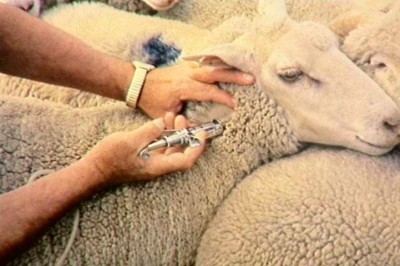Clostridial Disease Prevention by Vaccination in Lambs and Kids
Amy Barkley, Team Leader & Livestock Specialist
Southwest New York Dairy, Livestock and Field Crops Program

Clostridial Disease Prevention by Vaccination in Lambs and Kids
By Amy Barkley, Livestock Specialist SWNYDLFC
Much of this information was originally shared by Dr. tatiana Stanton and Dr. Mary Smith.
Tetanus can be a devastating disease. It can kill a healthy animal in 3-21 days, depending on the exposure level and type of bacteria. The bacteria the cause the illness are found in soil, and enter an animal through wounds. In small ruminants, common wounds include the sides of the head following disbudding, where the testicles attach to the body following castration, the tail following docking, and the navel following birth. There is no way to prevent the bacteria from living in your soil, so it's a good idea to take steps to prevent disease. Vaccination is a solid preventative measure that can save you trouble down the road, seeing that antitoxins aren't reliable in most production scenarios.
Besides the bacteria that cause lockjaw, Clostridium perfringens C & D can cause what we call "overeating disease" or "pulpy kidney disease". This bacteria is found in the healthy intestinal tracts and tends to cause issues with a sudden change in feed, especially diets heavy in grain, causing a toxic reaction. Unlike tetanus, which can affect any animal in the flock, this disease usually occurs in the largest, fastest-growing ones. This disease does not respond well to antitoxins, either, so vaccination is a key to prevention.
Does and ewes can transfer immunity to their offspring shortly after birth through colostrum. Immunity only passes through the colostrum, and not through the placenta. As part of a herd health plan, does and ewes should receive at least two boosters of the vaccine 3-4 weeks apart to build the initial immunity, followed by an annual vaccine at least 10 days prior to birthing (ideally 3-6 weeks). This stringent timeline is required because the dam needs time to build her own immunity before passing the immune cells to her offspring through the colostrum. The recommended type of vaccine includes protection against Clostridium perfringens C & D as well as a tetanus toxoid.
For the kids or lambs themselves, so long as they receive sufficient colostrum, they will start their booster vaccination program between 6-10 weeks of age. They will also need to be provided Clostridium perfringens C & D and a tetanus toxoid. Following the initial vaccination, they'll receive the second booster 3-4 weeks after the first. If you are feeding a grain-heavy diet, talk with your veterinarian about increasing the number of booster doses for added protection.
If you are unsure whether or not your lambs or kids received sufficient colostrum or if they're from an unvaccinated dam, they should receive the tetanus antitoxin shot shortly after birth and prior to tail docking, disbudding, or castration. Very young animals aren't able to build immunity very well until they're around 6-10 weeks of age, which is why vaccination isn't effective enough to provide protection until this time. The antitoxin helps prevent the bacteria from taking hold until they are old enough to build their own immunity through vaccination.
Dr. Mary Smith shares the following reminders for vaccinating for tetanus:
- Subcutaneous injection works best, so long as the vaccine you're using is labeled for it. The vaccine will result in lumps, which are longer lasting if the vaccine is placed in the skin or muscle.
- Vaccinate high on the neck, and work with your veterinarian to learn the proper technique.
- Do not vaccinate wet animals as it predisposes them to abscesses
- Refrigerate vaccines
- Swab top of bottle with alcohol if dust on it (killed vaccines)
- Only a sterile needle ever goes in the stock bottle
- New needle for each goat if possible
- Do not mix vaccines with other vaccines or drugs
- Use a clean syringe for each animal
- Read label for meat and milk withdrawals
- Read label for other safety concerns
- Keep written records of vaccination dates
- Dispose of needles, syringes, empty or unused vials properly using a glass jar or biohazard container
- Epinephrine is the antidote for anaphylactic reactions. The ruminant dose is 0.5 to 1.0 ml/100 pounds of the 1:1000 product IM or SC.
For more information on common clostridial disease, please visit the College of Veterinary Medicine's Website.
Upcoming Events
Advanced Hoof Health Program
January 15, 2026
Belfast, NY
Who should attend?
- Professional hoof trimmers
- Dairy farm owners or managers in charge of farm foot health
Topics include:
- How to Create a Strategic Trimming Program for your Dairy
- The Latest in Lameness Technology for the Dairy Industry
- Housing and Flooring Design: Its Role in Hoof Care
NY Pork Producers Connection Breakfast - Geneseo
January 17, 2026 : Pork Producers Connection Breakfast - Geneseo
Geneseo, NY
All pork producers are invited to join the New York Pork Producers for a free hot farmer's breakfast, at which they'll catch up on topics including the pork to dairy barn conversion series, NYPP digital campaigns, and 840-RFID tags.
Boots in the Barn: Cornell Dairy Research Updates
January 13, 2026
January 20, 2026
January 27, 2026
February 3, 2026
February 10, 2026
February 17, 2026
February 24, 2026
Join us for some or all!
Announcements
Cows, Crops & Critters Newsletter Sponsorship
TRYING TO REACH GROWERS AND AGRIBUSINESSES IN OUR SOUTHWEST REGION OF NEW YORK?Weekly Email Update: Shared with 625+ households who have signed up with our program.
Monthly Paper Mailer: To reach our stakeholders and farmers who lack internet access, we send out a monthly mailer where your company's logo and contact information would be featured with a mailing list of 330+ households.
If you sponsor our weekly and monthly publications you reach approximately 955 households.





